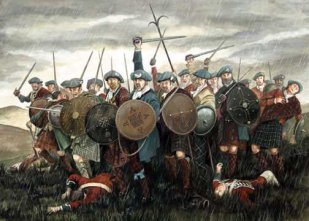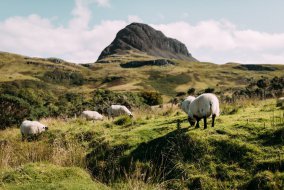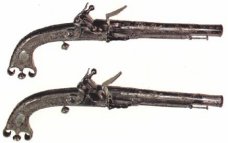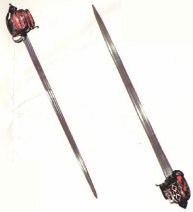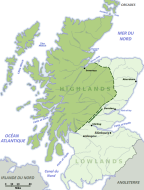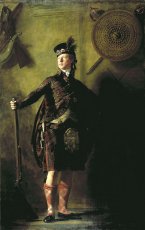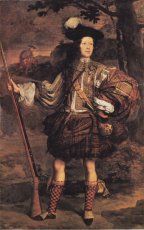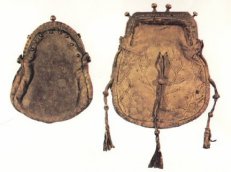Les clans étaient fréquemment en guerre pour défendre leurs terres et leurs troupeaux, et les chefs menaient les troupes. Ils avaient un grand pouvoir et résidaient dans des forteresses, sièges du clan. Les chefs devaient à leurs membres de bien administrer le territoire, et les membres devaient aux chefs declans de prendre les armes quand ces derniers le jugeaient bon.
Si les membres du clan leur versaient des contributions, c’était en nature, et parfois abondamment, ce qui permettait aux chefs l’exercice d’une exubérante hospitalité.
Par exemple, vers 1680, MacLeod, chef du clan du même nom, recevait, de l’ensemble des terres où s’exerçait son autorité, 9 000 poules par an et ,de la seule île de Skye, plus de 3 000 kilos de beurre.
D’autres familles, appelées septs (l’expression venant probablement du mot "sect" qui s’est transformé au fil du temps), portant d’autres noms, reconnaissaient certains chefs et s’intégraient ainsi à leur clan.
Par exemple, la famille Burns, qui était très petite et avait un héritage incertain, avait gagné la légitimité et la protection du Clan Campbell qui l’a donc absorbée.
Chaque clan écossais avait traditionnellement un certain nombre de septs, chacun avec son propre nom de famille.
Les septs avaient le droit de porter les tartans du clan auquel ils appartenaient sans que cela ne soit pourtant une obligation.
Le Sgian Dubh (prononcer skin dou) signifie "lame sombre" en gaélique et désigne le petit couteau à un seul fil tranchant.
Originairement utilisé pour manger et préparer les fruits, la viande, couper le pain et le fromage, ainsi que pour tout autre usage quotidien comme couper des matériaux et se protéger, il est aujourd'hui porté comme un élément de la tenue traditionnelle écossaise, glissé dans le bas, en laissant visible seulement la partie supérieure à la garde.
Les épées à deux mains étaient déjà utilisées par les combattants européens avant le XVe siècle. Le type écossais de cette arme, caractérisée par une extrémité en quatre lobes et une garde entièrement ajourée, s'est développé durant le siècle suivant. Des épées avec de telles poignées sont rares, mais sont représentées sur les tombes de l'Ouest des Highlands. Elles sont connues sous le nom de Claymores ( du gaélique Grande épée). Le nom est parfois utilisé pour les épées plus courtes qui leur ont succédé, qui pourraient être plus correctement décrites comme des épées à poignées en corbeille.
Ce cornet est en corne de vache, chauffée pour que celui qui l'a fabriqué puisse l'aplatir, puis décorée à l'aide d'une combinaison de motifs celtes et Renaissance, comme on en trouve sur les cornets à poudre allemands et hollandais.
La forme de la poignée de ces pistolets en acier, en corne de bélier, est typique de l'époque et de la région. La crosse et le corps sont damasquinés avec des motifs en argent. Ces pistolets étaient ceux des chefs. L'homme du rang ne pouvait espérer en posséder d'aussi beaux.
La targe, ou bouclier, fait environ 35cm de diamètre, et est constituée de deux couches de bois de chêne recouvertes de cuir de vache. Au dos se trouve une sangle pour le bras et une poignée. La surface est décorée de clous et plaques de cuivre, aussi fonctionnels que complémentaires avec la forme prise par le cuir repoussé. Au centre se trouve une bosse de cuivre, parfois agrémentée d'une pique en fer. Cette targe date de 1715, et ses décorations sont en argent.
Le Dirk est une arme écossaise ayant évolué à partir d'un prédécesseur européen. C'est une arme d'estoc, portée à la ceinture dans une gaine en cuir hors des batailles, et dans la main tenant la targe en combat. Les Dirks du XVIIe siècle ont des gardes réduites mais des pommeaux très larges et aplatis. La garde est généralement de bois, plus rarement de bronze ou de cuivre, et est décorée de courbes entrelacées. Le Dirk tomba finalement en désuétude et devint un élément du costume traditionnel, avec une garde à balustre et montée de pierres de Cairngorm.
Les broches rondes à surface plate apparaissent pour la première fois en Europe au XIIIe siècle. Les broches d'argent ou de cuivre portées par les femmes des Highlands sur la poitrine pour tenir leurs plaids sont leurs descendantes directes. Les décorations gravées de celles du XVIIe siècle consistent en des animaux stylisés, de formes végétales et de ronds enlacés.
La bourse, appelée "sporran", portée avec le plaid à ceinture, puis plus tard avec le kilt, était un sac de cuir fin garni au sommet de lanières de cuir et suspendu à la taille par la ceinture. Cette bourse, et ses dérivés postérieurs renforcés de cuivre sur le haut du rabat, sont des versions adaptées aux matériaux des Highlands des bourses du Moyen Âge. Les renforts en cuivre apparaissent vers 1700.
Les membres des clans écossais se distinguaient également par leurs tenues traditionnelles.
C'est dès le XVe siècle que les textes écossais font mention de vêtements portant des carreaux ou des rayures. Les comptes rendus de voyage et les portraits des deux siècles suivants nous en apprennent beaucoup sur les vêtements des Highlanders - plaids, vestes et pantalons en tartan - alors que le kilt traditionnel évoluait pour être ce que l'on connait maintenant. Les portraits nous montrent que les tartans étaient couramment portés et qu'une même personne pouvait porter plusieurs couleurs.
Après la défaite de Culloden, en 1746, le Parlement a, entre autres, interdit le port du tartan car la relation étroite existant entre "le costume des Higlanders" et l'esprit guerrier des hommes portant les armes était devenue trop flagrante. Cette prohibition s'appliqua à tous, excepté aux forces de "sa Gracieuse Majesté".
Cette loi fut abrogée en 1782, pour autant, même si le tartant et les costumes traditionnels sont à nouveau portés par les écossais, ils ne sont plus forcément représentatif d'une appartenance à un clan particulier.
Les chefs de clans avaient une influence culturelle positive en entretenant les bardes chantant les louanges du clan, des harpistes et des sonneurs de cornemuse.
Dans ce contexte, les membres des clans se mirent à émigrer massivement vers l’Amérique (d’autres entrant en grand nombre dans l’armée britannique ou rejoignant les villes), d’autant plus que les anciens chefs, devenus des propriétaires terriens à la cupidité toute capitaliste, faisaient évacuer leurs terres pour développer l’élevage des grands moutons et fournir des zones de chasse aux riches Anglais.
Si les clans s’opposèrent souvent aux rois d’Écosse qui voulaient les transformer en seigneuries féodales pour les contrôler, ils s’affrontèrent également les uns les autres, car il n’était pas rare que deux clans revendiquent le même territoire. Aux conflits pour la possession des territoires s’ajoutaient ceux liés au soutien que les clans accordaient ou non aux rois d’Écosse, aux royalistes ou à leurs adversaires durant la Guerre Civile du XVIIe siècle, aux Stuarts ou à l’Angleterre au XVIIIe siècle (et des différences religieuses, plus ou moins motivées par la politique, intervenaient aussi).
Au XVIIe siècle, du fait de l’influence anglaise, l’obligation de défendre le chef de clan par les armes (contre les autres clans) fut remplacée par le devoir de lui payer une sorte d’impôt ou de loyer, alors que la terre, qui avait jusque-là fait office de récompense en échange de loyaux services militaires, se transforma progressivement en marchandise qu’il devint possible d’acheter, de vendre et de transmettre par voie de succession.
Peu à peu, les chefs de clans se transformèrent en seigneurs féodaux qui exercèrent de plus en plus leur pouvoir seigneurial. Ainsi les chefs de clans portent parfois des titres de noblesse, comme le chef du clan Campbell qui est duc d’Argyll, le chef du clan Murray qui est duc d’Atholl, et certains chefs de clans sont lords ou comtes (lord Reay pour le chef du clan MacKay, lord Saltoun et lord Lovat pour les chefs du clan Fraser, comte de Cromartie pour le chef du clan MacKenzie).
Mais jusqu’au XVIIIe siècle, dans les Highlands et les Iles, l’esprit du système clanique se maintint. Un bon nombre de clans se soulevèrent encore pour appuyer le Prétendant Charles-Édouard Stuart (écossais par sa famille) lors de sa tentative de retrouver le trône d’Angleterre en 1745, mais la répression qui suivit la défaite de Culloden écrasa les anciennes coutumes et institutions (le port des armes, du kilt et la pratique de la cornemuse furent interdits, l’usage du gaélique fut découragé, l’Acte sur les Juridictions héréditaires mit fin à l’autorité féodale des chefs).
On dit que seul Alastair MacDonell de Glengarry (1771-1828) resta fidèle aux anciennes valeurs.
Une pratique, autrefois répandue au sein des clans d’Écosse, était le vol de bétail, qui revêtait diverses significations.
Il s’agissait parfois tout simplement d’une appropriation d’animaux prélevés dans les Lowlands ou dans l’une des rares régions économiquement riches des Highlands (Moray ou Angus), envers lesquelles les Highlanders revendiquaient un droit de pillage, en vertu de traditions aussi anciennes que nébuleuses.
Le vol de bétail pouvait également être la conclusion d’une expédition victorieuse sur le territoire d’un clan ennemi ou la spécialité de certains clans (MacFarlane, MacLan, Cameron, Stewart d’Appin, Campbell de Glen Orchy) ou de « broken men » (personnes n’ayant plus de liens avec leur clan d’origine), dont c’était là la seule ressource.
De même, le vol d’un petit troupeau de bétail comptait au nombre des incontournables épreuves que devait exécuter un jeune chef de clan afin de prouver sa valeur et acquérir le prestige inhérent à ses aspirations. Dans la plupart des cas, ses bêtes étaient récupérées par une bande de jeunes hommes du clan spolié, acquérant ainsi également leur statut de guerriers, sans qu’il soit nécessaire de déclencher des hostilités interclaniques.
Dans certains cas, le vol pouvait s’accompagner de véritables provocations aux conséquences parfois dramatiques (expéditions punitives), bien qu’en règle générale les issues sanglantes aient été rares.
Les clans se caractérisaient par la possession collective d’un territoire administré par leur chef au bénéfice de tous les membres (ainsi les MacDonalds étaient installés dans divers lieux, dont l’île d’Islay et l’île de Skye, les Macleans, dans les îles de Mull, de Tiree et de Coll, les Mackays dans le Sutherland (nord-ouest), les Camerons dans le Lochaber (région du Ben Nevis) et les Campbells dans l’Argyll (sud-ouest des Highlands).
Les chefs et leurs officiers se chargeaient de la redistribution annuelle des terres.
Chacun des clans recherchait l’autosuffisance sur son propre territoire en élevant du bétail et en cultivant de l'avoine et de l’orge (dont ils faisaient du whisky). Il y avait peu d’artisans, car chaque paysan et sa famille effectuaient eux-mêmes la plupart des travaux concernant les tissus, le cuir et le fer.
Les paysans, quant à eux, pratiquaient une transhumance d’été rendue nécessaire par l’insuffisance de l’herbe autour des villages d’hiver. À la suite de ces déplacements, parfois fort éloignés du village d’hiver (jusqu’à une trentaine de kilomètres), les bêtes étaient, en règle générale, abandonnées à elles-mêmes dans les collines.
Le système clanique existait aussi hors des Highlands.
Ainsi le clan Douglas contrôlait une partie des Lowlands (ou « basses terres », qui désignent les parties de l'Écosse qui n'appartiennent pas aux Highlands bien que ne constituant pas une zone géographique officielle du pays).
Il pouvait y avoir plusieurs branches d’un clan avec chacune un chef. Ainsi il y avait plusieurs branches des MacDonalds (MacDonald de Sleat, MacDonald de Clanranald, MacDonald de Keppoch,) et des Campbells (Campbell d’Argyll, Campbell de Breadalbane, Campbell de Cawdor).
Le mot « clan » signifie « rejetons, bourgeons, enfants, famille » et l’idée sous-jacente à la vie des clans était l’origine de tous les membres à partir d’un ancêtre commun qui était, par le fait, doté d’un grand prestige. C'est ainsi que tous les membres du clan portaient le même nom.
Dans les Highlands, ce nom commençait par le préfixe "Mac" ("fils de" en gaélique), suivi du nom de l’ancêtre commun (par ex : MacDonald, MacDougall, MacLeod, etc.) ; mais d’autres noms gaéliques existaient également, comme Cameron (qui signifie "nez tordu") ou Campbell (qui signifie "bouche tordue"). Dans les Highlands, il y avait aussi des clans d’origine normande, comme les Grant et les Sinclair.
Par ailleurs, si tous les membres du clan portaient le même nom de famille, traditionnellement seul le chef se réclamait de ce nom. Ainsi, le chef du clan MacFarlane était appelé "MacFarlane", sans référence à son prénom, et sans utiliser la formule de politesse "monsieur" ; les hommes de qualité du clan étaient appelés par leur nom complet, selon les conventions habituelles. En revanche, les membres mineurs étaient appelés par leur seul prénom, auquel était accolé leur lieu de résidence, par exemple "Iain de Tallisker".
Le système écossais des clans est une société dans laquelle la collectivité prime sur les individus qui lui sont totalement intégrés (c’est un système typiquement gaélique qui existait également en Irlande, dont un bon nombre d’Écossais étaient originaires).
Le membre d’un clan qui refusait de risquer sa vie pour protéger son chef était considéré comme un traître, et le mépris qu’on lui portait était son châtiment le plus cruel. Il se trouvait également des situations où le membre d’un clan pouvait être jugé et puni pour un délit, à la place d’un autre membre du clan qui aurait tenté de s’y soustraire.
Les clans étaient représentés par un tartan (couleurs et dessins particuliers sur les vêtements traditionnels), une devise (la devise du clan MacDonald est « Per mare per terras », « Sur la mer et dans les terres »), et un insigne végétal, à sens souvent magique, porté sur une pique ou au bonnet.
Les clans écossais


Par Valérie Gay-Corajoud




